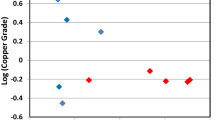Abstract
The use of multifractals in the applied sciences has proven useful in the characterization and modeling of complex phenomena. Multifractal theory has also been recently applied to the study and characterization of geochemical distributions, and its relation to spatial statistics clearly stated. The present paper proposes a two-dimensional multifractal model based on a trinomial multiplicative cascade as a proxy to some geochemical distribution. The equations for the generalized dimensions, mass exponent, coarse Lipschitz–Hölder exponent, and multifractal spectrum are derived. This model was tested with an example data set used for geochemical exploration of gold deposits in Northwest Portugal. The element used was arsenic because a large number of sample assays were below detection limit for gold. Arsenic, however, has a positive correlation with gold, and the two generations of arsenopyrite identified in the gold quartz veins are consistent with different mineralizing events, which gave rise to different gold grades. Performing the multifractal analysis has shown problems arising in the subdivision of the area with boxes of constant side length and in the uncertainty the edge effects produce in the experimental estimation of the mass exponent. However, it was possible to closely fit a multifractal spectrum to the data with enrichment factors in the range 2.4–2.6 and constant K1 = 1.3. Such parameters may give some information on the magnitude of the concentration efficiency and heterogeneity of the distribution of arsenic in the mineralized structures. In a simple test with estimated points using ordinary lognormal kriging, the fitted multifractal model showed the magnitude of smoothing in estimated data. Therefore, it is concluded that multifractal models may be useful in the stochastic simulation of geochemical distributions.
Similar content being viewed by others
REFERENCES
Agterberg, F. P., 1995, Multifractal modeling of the sizes and grades of giant and supergiant deposits: International Geology Review, v. 37, p. 1–8.
Agterberg, F. P., Cheng, Q., Brown, A., and Good, D., 1996, Multifractal modeling of fractures in the Lac du Bonnet batholith, Manitoba: Computers & Geosciences, v. 22, no. 5, p. 497–507.
Agterberg, F. P., Cheng, Q., and Wright, D. F., 1993, Fractal modeling of mineral deposits, in Elbrond, J., and Tang, X., eds., International Symposium in the Application of Computers and Operations Research in the Mineral Industries, Institution of Minning and Metallurgy: Montréal, Québec, Canada, p. 43–53.
Cheng, Q., 1997, Discrete multifractals: Math. Geology, v. 29, no. 2, p. 245–265.
Cheng, Q., 1998, Stochastic simulation and discrete multifractals, in Buccianti, A., Nardi, G., Potenza, R., eds., IV IAMG'98, v. 2, De Frede, Ischia Island, Italy, p. 572–577.
Cheng, Q., 1999, Spatial and scaling modelling for geochemical anomaly separation: Jour. Geochemical Exploration, v. 65, no. 3, p. 175–194.
Cheng, Q., and Agterberg, F. P., 1995, Multifractal modeling and spatial point processes: Math. Geology, v. 27, no. 7, p. 831–845.
Cheng, Q., and Agterberg, F. P., 1996, Multifractal modeling and spatial statistics: Math. Geology, v. 28, no. 1, p. 1–16.
Cheng, Q., Agterberg, F. P., and Ballantyne, S. B., 1994, The separation of geochemical anomalies from background by fractal methods: Jour. Geochemical Exploration, v. 51, no. 2, p. 109–130.
Chhabra, A. B., and Sreenivasan, K. R., 1991, Negative dimensions: Theory, computation, and experiment: Physical Review A, v. 43, no. 2, p. 1114–1117.
de Wijs, H. J., 1951, Statistics of ore distribution: Geologie en Minjbouw, v. 13, no. 11, p. 365–375.
Evertsz, C. J. G., and Mandelbrot, B. B., 1992, Multifractal Measures (Appendix B), in Peitgen, H. O., Jurgens, H., and Saupe, D., eds., Chaos and fractals: Springer-Verlag, New York, p. 921–953.
Feder, J., 1988, Fractals: Plenum Press, New York, 283 p.
Gonçalves, M. A., 1996, Mineralizações auríferas da região de Arouca: M.Sc. thesis, Faculdade de Ciências da Universidade de Lisboa, 111 p.
Gonçalves, M. A., Vairinho, M., and Oliveira, V., 1998, Study of geochemical anomalies in Mombeja area using a multifractal methodology and geostatistics, in Buccianti, A., Nardi, G., and Potenza, R., eds., IV IAMG'98, v. 2, De Frede, Ischia Island, Italy, p. 590–595.
Halsey, T. C., Jensen, M. H., Kadanoff, L. P., Procaccia, I., and Shraiman, B. I., 1986, Fractal measures and their singularities: The characterization of strange sets: Phys RevA, v. 33, no. 2, p. 1141–1151.
Journel, A. G., and Huijbregts, C. J., 1978, Mining geostatistics: Academic Press, London, 600 p.
Leduc, C., 1990, Interpretation des résultats de la prospection geochimique strategique sur la zone C, Baixo Douro (Portugal), Rapport BRGM Note DAM/DEX/T2M/CL/SM1845/90, 19 p.
Mandelbrot, B. B., 1989, Multifractal measures, especially for the geophysicist: Pure Appl Geophys v. 131, no. 1/2, p. 5–42.
Mandelbrot, B. B., 1990a, Negative fractal dimensions and multifractals: Phys A, v. 163, p. 306–315.
Mandelbrot, B. B., 1990b, New “anomalous” multiplicative multifractals: Left sided f (α) and the modelling of DLA: Phys A, v. 168, p. 95–111.
Meneveau, C., and Sreenivasan, K. R., 1987, Simple multifractal cascade model for fully developed turbulence: Phys Rev Lett, v. 57, p. 1424–1427.
Sim, B. L., Agterberg, F. P., and Beaudry, C., 1998, Determining the cutoff between background and anomalous metal concentration in lake sediments for the Frotet area, Quebec, using multifractal methods, in Buccianti, A., Nardi, G., and Potenza, R., eds., IV IAMG'98, v. 2, De Frede, Ischia Island, Italy, p. 612–617.
Stanley, H. E., and Meakin, P., 1988, Multifractal phenomena in physics and chemistry: Nature, v. 335, p. 405–409.
Turcotte, D. L., 1997, Fractals and chaos in geology and geophysics: Cambridge University Press, 398 p.
Author information
Authors and Affiliations
Rights and permissions
About this article
Cite this article
Gonçalves, M.A. Characterization of Geochemical Distributions Using Multifractal Models. Mathematical Geology 33, 41–61 (2001). https://doi.org/10.1023/A:1007510209836
Issue Date:
DOI: https://doi.org/10.1023/A:1007510209836




